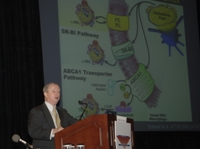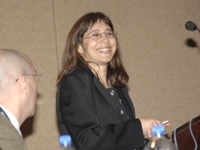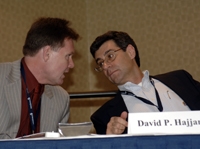Weill Cornell Medical College helped welcome physicians from around the world to the Lorenzini Symposium on triglycerides and HDL, held at the Marriott Marquis in Times Square on July 14-17.
Dr. Antonio Gotto, dean of the Medical College, delivered the opening remarks on risk factors for coronary artery disease (CAD), outlining the roles of HDL (or "good" protective cholesterol) and triglycerides in prevention. Many landmark studies at Weill Cornell have filled in key pieces of the puzzle.

Dr. Antonio Gotto delivers his lecture, "HDL and Triglycerides: An Evolving Story in Cardiovascular Prevention" at the 2nd International Symposium on Triglycerides and HDL.
"Significant progress has been made in understanding how HDL and triglycerides are involved in cardiovascular disease," Dr. Gotto said. "Therapies targeting lowered HDL and elevated triglycerides as components of metabolic syndrome may help to achieve risk reduction. We're getting closer to HDL therapy as a means of battling cardiovascular disease."
Dean Gotto also discussed metabolic syndrome: a constellation of risk factors such as fat around the middle, increased triglycerides, lowered HDL, and insulin resistance that could lead to diabetes, especially exacerbated by high-carbohydrate, high-sugar diets.
The symposium's first plenary session, steered by Dean Gotto, invited experts to consider the prevalence of metabolic syndrome, which by some estimates afflicts a quarter of the U.S. population, and is rapidly spreading in other countries to take on the contours of a worldwide problem. Initial studies have painted a grim picture of a cardiovascular mortality risk that increases severalfold with metabolic syndrome. The session also examined the link between atherosclerosis and metabolic syndrome. Giving drugs to lower LDL ("bad" artery-clogging cholesterol) and increase HDL demonstrably reduces the risk of CAD in high-risk patients.
A panel of Weill Cornell physicians, chaired by Dr. Robert Campagna, considered case studies of patients with challenging profiles of hypertriglyceridemia and hyperlipidemia — "oddball profiles" or outstanding cases of high triglycerides and low HDL — opening discussions of how to discern meaning in the patient histories and devise a strategy to proceed. They also discussed the way to motivate patients against many odds, and how to broach issues like diet, exercise, medication and cholesterol. All doctors discussed the importance of stressing weight loss and exercise as critical for their patients, to spur them to better health and curb the onset of diabetes. Dr. Keith Roach, associate professor of medicine and head of the Cornell Internal Medicine Associates, stressed the importance of a glucose tolerance test to ascertain diabetes in difficult patients. Efficient and cost-effective, the tests gave him and his colleagues a diagnostic certainty, Dr. Roach said.
Dr. Carol Levy, assistant professor of medicine in the Division of Endocrinology, discussed mechanisms for lowering glucose, including stimulating insulin secretion, decreasing hepatic glucose production and increasing muscle glucose uptake, aside from giving supplemental insulin. (The finer points of insulin therapy in difficult patients were discussed.) The efficacy of medications like metformin was debated, as well as oral diabetes medications' promising impact on metabolic syndrome. Dr. Levy mentioned some patients refuse to take the medications.
"It's hard to do battle with the rest of the world that's pushing fast food and a sedentary lifestyle," said Dr. Robert Campagna, associate professor of clinical medicine.
"But when you can do so, it's so rewarding," Dr. Roach pointed out.

Dr. Carol Levy discusses mechanisms for lowering glucose at a workshop presented by several Weill Cornell faculty, including Drs. Keith Roach, Erica Jones and Bruce Gordon.
Some doctors monitor their more motivated patients via e-mail to encourage weight loss and exercise. Dr. Erica Jones, associate professor of clinical medicine, presented case studies of heart disease and metabolic syndrome in overweight women. Dr. Jones brought up a case of an elderly woman who opted for herbal and homeopathic remedies while refusing to take the "synthetic" pills covered by Medicaid. Dr. Jones succeeded in convincing the woman to take certain medications. "You have to pick your battles," she said. For her part, Dr. Jones researched some of the herbal supplements and conceded that some — though not all — were innocuous and at least couldn't hurt.

Dr. David Hajjar (right) chairs a session entitled "Triglyceride-Rich Lipoproteins, Inflammation and Atherosclerosis."
Dr. Bruce Gordon, professor of clinical medicine, considered the onset of non-alcohol fatty liver disease (NAFLD) in a patient with elevated cholesterol and triglycerides, and low HDL, and debated the merits of various therapies under consideration. NAFLD is linked with obesity, diabetes and metabolic syndrome. Dr. Gordon mentioned he was at a crossroads with patients who have gained weight or reached a plateau and discontinued their medication, and sought advice from the audience of physicians. The physicians from other countries, it seemed, took a harder line on weight loss than the Americans, insisting that "weight loss was the only answer" rather than relying on a cocktail of medications.
On Saturday, July 16, Dr. David Hajjar, dean of the College of Medical Sciences, chaired a session on triglyceride-rich lipoproteins, inflammation and atherosclerosis. He presented a paper authored by Weill Cornell faculty on pitavastatin in arterial cholesterol trafficking. In this cellular-level study, Dr. Hajjar detailed how statins regulate cell activity through microphage scavenger receptors, involved in cholesterol delivery to the vessel wall. The paper found that statins decrease cholesterol uptake while lowering LDL. Pivastatin has a significant effect on signaling molecules — an overall "beneficial trafficking effect," Dr. Hajjar said. Pinpointing statin's effects on the arterial wall, including the mechanisms of cholesterol transport, could shed new light on their array of benefits to patients, beyond their anti-inflammatory abilities, Dr. Hajjar said.
Photos by Amelia Panico.

